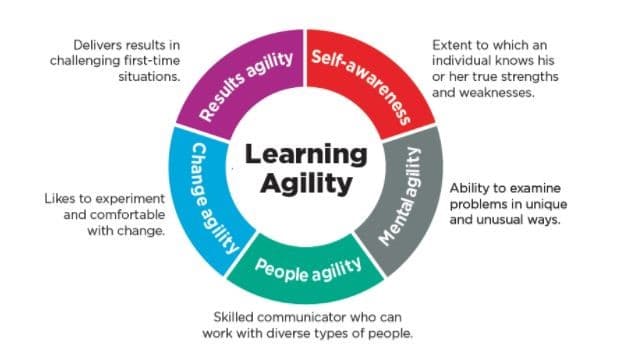The concept of Learning Agility dates back to 1970, when American author Alvin Toffler in his book Future Shock, investigated the move from the traditional industrial age to a new age dominated by Information. He crafted a new definition of what literacy meant, anticipating by a decade the more complete definitions of Learning Agility:
The illiterate of the 21st century will not be those who cannot read and write, but those who cannot learn, unlearn, and relearn
Alvin Toffler, Future Shock, 1970
The switch from a concept of Literacy based on the simple accumulation of “stocks” of information, changes into a fluid model where the learning and unlearning have the same relevance. It’s this dynamic element that is the innovative portion of this skill’s definition.
Today this skill is in high demand and has been strongly associated with Leadership. Put simply, “it’s the ability to be in a novel situation, not know what to do, and then figure it out anyway. Individuals who learn the ‘right’ lessons from past experiences are high in learning agility, meaning they’re able to identify the most important info in one situation and connect it to the right context in a new situation”.
Learning agility is finding yourself in a new situation and not knowing what to do – but then figuring it out.
Why is Learning Agility important?
Learning agility is often linked to innovation, but also to the capacity to anticipate trends, and operate in situations marked by uncertainty. All these elements are key in the modern scenario for companies. Strongly supported by Curiosity, this trait allows leaders (but from my point of view also other Knowledge Workers) to constantly improve. It is a key feature of what Francesca Gino calls “Rebels”, and an asset for companies like Pixar. And it is linked to one of the key motivation drivers identified by Daniel Pink.
Can it be measured?
Korn/Ferry has developed a model for measuring Learning Agility. This model measures learning agility through four separate factors and one transcending element: self-awareness. This last element strongly affects the other four.

What’s interesting is that by looking at the full model above, Korn/Ferry has discovered that a mere 15% of leaders have a strong level of Learning Agility, making this a scarce competency among talent.
Another model has been created by Dr W. Warner Burke of the Teachers College at Columbia University, who broke the concept of Learning Agility down into 9 clusters:
- Feedback-seeking – asking others for feedback on performance
- Information-seeking – the desire to update knowledge and expertise
- Performance Risk Taking – taking on new roles and assignments that are challenging and volunteering for activities where you aren’t quite sure what you’re getting yourself into, but you know you can have fun and learn.
- Interpersonal Risk Taking – sharing/disclosing mistakes with others
- Collaborating – working with colleagues from different backgrounds to share perspectives
- Experimenting – testing out unproven ideas and moving on when it doesn’t work out (this includes a tolerance for failure)
- Reflecting – critically evaluating events with others in order to understand what happened
- Flexibility – the ability to shift, such as finding common themes among opposing points of view
- Speed – moving on quickly and not dwelling unnecessarily
How can I develop my Learning Agility?
Probably a first step is to understand where you stand today. If you want to measure your own levels of LA, there are three online testings available: Mettl Learning Agility Assessment, Korn/Ferry ViaEdge Self-Assessment and Burke’s Learning Agility inventory. This will probably allow you to establish in which area there are Gaps, that you can fill in by focusing on the relevant behavior.
The Center for Creative Leadership has developed a simplified model, that focuses on behaviours grouped into 4 “enablers” and 1 “derailer”. You can use this model as a self-reflection mechanism:
Innovate
- For each problem you face, challenge yourself to come up with new solutions, even if seemingly tried and trusted ones exist.
- Make brainstorming new ideas a habit—the less traditional, the better.
- When faced with a challenge, ask yourself two questions:
- What is holding me back from trying something new and different?
- If these constraints were not in place, how would I approach this situation differently?
Perform
- When faced with something new, look for similarities between the situation and things you have done in the past. Draw on these similarities to frame the new challenge.
- Ask questions to understand, not to be understood. Really listen to what others are saying and trust that you will have a response when they have finished talking.
- When you find yourself feeling stressed, pause. Don’t just say or do the first thing that comes to your head—take a moment to consider what is really required.
Reflect
- Find someone who you trust to give you open and honest feedback and challenge that person to do so. Show that you are open to the process by only asking clarifying questions. Resist the temptation to explain your actions or make excuses.
- Conduct After Action Reviews where you, and relevant others, reflect on recent projects by asking three questions:
- What happened?
- Why did it happen that way?
- What should we stop/start/continue doing in order to ensure success in the future?
Take Risks
- Take on a new challenge that scares you; find something that is meaningful but not so important that failure will have serious personal consequences. Most importantly, tell others what you are doing—ask for their help and support.
Defend (derailer)
- View feedback as a gift that someone is giving you. you may not like it and it may be uncomfortable, but there is value in it nonetheless. Regardless of the other party’s motivations for giving you feedback, there is always the opportunity to learn something about yourself that you previously did not know.
- Resist the temptation to respond to feedback, especially at first. Try not to explain your actions to the other person or generate excuses in your own head. Always try to thank the other person.
How do I develop Learning Agility in others?
Whatever model you pick, several of the dimensions of Learning Agility depend on the openness to being wrong. This aspect, which is key in the unlearning process, is a key success factor that as a manager you can enable. Too often corporate cultures discredit errors, a situation that in the long term becomes a derailer for the development of Learning Agility. Something we have read extensively in Ed Catmull and Laszlo Bock books.
We have found that learning ability is the leading predictor of success, number one above intelligence and education!
Laszlo Bock
As usual, there are three steps that you should take to focus on the correct behaviours.
- Model it. Make space for Learning first and foremost. Show your team that you personally take time to learn new things and that you learn from mistakes. I thought I could reach the goal using this method, but I was wrong, so I had to go back and start again. This will put you in a position of really leading by examples.
- Enable it. Ensure that people in your team can learn from errors. This is the fuel of the agility component. Organize sessions where as a team you reflect on what went wrong, not for punishment, but for a celebration of what learnings you have derived.
- Celebrate it: take the time to reward the members of your teams that are able to make learnings out of an error, or move out of their comfort zones.
Let’s check this up
Let’s do a pulse check on how you personally are doing in terms of Learning Agility. Think about the last week at work or at home, how many of the following statements are true?
- I’ve asked for feedback on how I’m doing on my job.
- I’ve taken time to learn something new about the issues I was tackling.
- I’ve volunteered for a new activity or task, even if I did not have all the information and knowledge about it.
- I’ve shared an error I’ve done with a member of my team, seeking support in understanding how I could have done better.
- I’ve looked for a different perspective with a colleague outside my team.
- I’ve tried something new in a task that I normally perform.
- I’ve taken time with my team to reflect on the outcomes of a project or activity.
And you? What do you think about Learning Agility?

What Skills for the Future of Work?
This post is part of a series of articles on Skills and Competencies required to succeed in the Future of Work. Read the main article, and access all the other available posts.

[…] what are the advantages of reading? Easy: it gives a real boost to my Learning Agility, wakes up curiosity. It allows me to discover a lot of new things. On a personal basis, it will […]
[…] he speaks about his role and his personal Purpose, Catmull focuses on learning. After the analysis of the first movie created at Pixar, he focused on one key question for himself […]
[…] of the competencies we have identified for the Future of Work: Listening, Curiosity, Authenticity, Learning Agility, Decision […]
[…] is the spirit of continually focusing on curiosity and Learning Agility as a critical feature that can sustain the work of the […]
[…] they don’t feel the need for it. It is, therefore, important to stimulate creativity, listening, learning agility so that people can think “out of the box” and see any improvement […]
[…] with a lot of the critical skills we have already seen: Listening, Curiosity, Learning Agility, Decision […]
[…] still think we should consider this a gift. Because that view of the world is the key in allowing us to learn from errors. If everything would be perfect, we would also cease to be curious. Plus, it allows us to be more […]